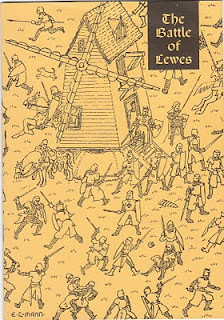Book Review: E.L.Mann's 'The Battle of Lewes'
Published in 1976 by M Harman St Nicholas Bookshop, Lewes, this pocket sized 32 page account appears to be aimed at the tourist, high school student or as an introduction to the subject of the battle at Lewes. It is a general account, not academically referenced and E L Mann's self drawn map is simplistic. The author does go into some considerations and analysis not found elsewhere. It is to be remembered that by the date of publication, subsequent academic treatments such as Dr Carpenter's Battles of Lewes and Evesham remained many years in the future.
Under the 'Notes' section (page 27) the author discusses strategy. Mann's position that the size of the armies present being comparable for an engagement to have occurred forms the basis of a criticism of Henry in giving up a strong, fortified defensive position. This and the declaration of no major battle having been fought in England for fifty plus years forms the basis for commenting that military organisation or skill could not have been of a high order. The final impetus for battle is blamed on the protagonists pursuit of honour and glory, routed in chivalric concepts of the day. I will discuss these concepts in a future discourse.
There is a detailed list of major characters who led both sides into battle and some discussion of arms and armour with an expansion on the subjects of 'mail' and 'shields'. Some highly debatable comments such as ' ... the all-conquering longbow of the next century was not yet developed' and accompanying statements such as 'Bows were small and inaccurate and arrows could be dodged or caught harmlessly on shields ...' stand unsupported in the text.
This account is a quick, enjoyable read and whilst arguably dubious comments are to be found throughout the text, it does contribute to the general body of knowledge for the battle of Lewes even if eclipsed by subsequent works. As a final note, wargamers might find the cover (pictured above) of interest for two reasons. It depicts an impression of the windmill in which Richard of Cornwall is said to have held up during the royal rout. Observe the character wearing the crown and consider that Richard, as King of the Romans might have worn a crown on the day. Clearly the windmill, in whatever fashion I research, will feature on my miniature battlefield and will have sails.




Comments